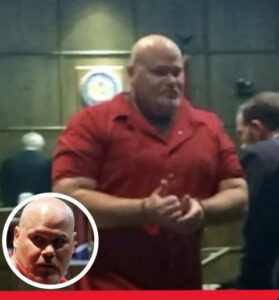Death Row Inmate’s Plea for Fingerprint Testing Backfires — New Evidence Confirms His Guilt

What began as a desperate attempt to prove innocence has taken a shocking turn. Tennessee death row inmate Marlon Kiser, who has spent years claiming he was framed for the 2001 murder of Hamilton County Deputy Donald Bond, recently received the results he’d long demanded — and they only deepened the case against him.
A Fight to Clear His Name
Convicted in 2003, Kiser has maintained that he was wrongfully accused and that the true killer was his former roommate, James Michael Chattin. In an effort to expose what he believed was a grave injustice, Kiser launched a website, FreeMarlonKiser.com, and several online petitions to rally support.
On his site, Kiser painted a detailed picture of what he claimed had really happened. According to him, Chattin suspected that Deputy Bond was having an affair with his wife, Tina, and had openly threatened to kill the officer. Kiser wrote:
“Mike Chattin found out that his wife was seeing a deputy and said more than once he was going to kill him. And in the early morning hours of September 6th, 2001, that’s exactly what he did.”
Kiser argued that Chattin had used him as a scapegoat — especially since Kiser had previously filed a police brutality lawsuit against Chattanooga law enforcement, giving authorities what he believed was a motive to target him.
“To take suspicion off himself, Mike Chattin pointed the finger at me,” Kiser alleged.
He also claimed their friendship had soured when he discovered Chattin’s involvement with drugs and refused to be part of it — a falling-out that he said made him a liability.
“He couldn’t let me walk away,” Kiser wrote. “I knew too many of his secrets.”
Public Support and Legal Push
Kiser’s campaign drew attention online. His petition calling for a stay of execution and new evidence testing collected hundreds of signatures. Supporters accused investigators of corruption and mishandling evidence, insisting that Kiser had been framed.
One supporter commented:
“He’s on death row because of police corruption. Marlon knew too much about Chattin’s crimes.”
The DNA Request That Changed Everything
As part of a new motion for post-conviction relief, Kiser’s legal team requested forensic retesting of palm and fingerprint evidence from Deputy Bond’s patrol car and flashlight. They hoped the results would clear him — or at least introduce reasonable doubt.
But the outcome was devastating to his case.
Laboratory tests confirmed that the fingerprints matched Marlon Kiser himself, not Chattin or any unknown person. Combined with other forensic evidence, including fibers from the victim’s uniform found on Kiser, the new findings only reinforced the jury’s original conclusion.
A Costly Attempt at Vindication
Legal analysts following the case noted that while Kiser’s public claims raised questions, the physical evidence ultimately told a different story. His push for new testing, intended to prove innocence, instead became further proof of guilt.
The case now stands as a striking reminder of how post-conviction appeals can backfire when fresh evidence supports the prosecution’s version rather than overturning it.
Still Proclaiming Innocence
Despite the latest results, Kiser continues to maintain that he was framed and insists that the “truth” has not yet come out. From his cell on death row, he continues to fight for a second chance — though, for now, both the courts and the evidence appear unshaken.